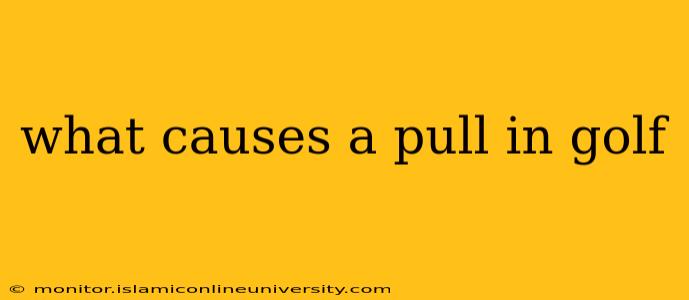A pulled shot in golf, often described as a hook for right-handed golfers (a slice for left-handed players), is a frustrating experience. It's that sudden, unwelcome leftward curve that sends your ball veering off course, leaving you scratching your head and wondering what went wrong. Understanding the mechanics behind a pull is crucial to correcting it and consistently hitting straighter shots. This article will delve into the common causes, offering insights to help you diagnose and rectify your pull.
What is a Pull in Golf?
Before we dive into the causes, let's clearly define a pull. A pulled shot in golf is characterized by a significant leftward deviation (for right-handed golfers) with little to no curvature. It's different from a hook, which involves a curving trajectory to the left. A pull is a straight, albeit errant, shot that heads left immediately off the clubface. This often results from a combination of factors affecting the club path, face angle, and swing mechanics.
Common Causes of a Pulled Golf Shot
Several factors can contribute to a pulled golf shot. Let's examine the most common culprits:
1. Outside-In Swing Path: A Primary Culprit
One of the most frequent causes of a pull is an outside-in swing path. This means your club travels from outside the target line, across the ball, and towards the inside. This path, combined with a square or even slightly closed clubface, sends the ball sharply to the left. Imagine a hammer hitting a nail; if you swing the hammer from outside the nail, it'll likely miss, similar to an outside-in swing path.
2. Over-Rotating the Hips and Shoulders
Excessive hip and shoulder rotation can also lead to an outside-in swing path. When your hips and shoulders rotate too far before the clubhead reaches the ball, your club's path naturally moves outwards. This early rotation throws your swing plane off and contributes directly to a pull.
3. Grip Issues: Too Strong or Weak?
Your grip plays a vital role in clubface alignment. A grip that's too strong (left hand too far over to the right) can cause a closed clubface at impact, further exacerbating an outside-in swing path and leading to a pull. Conversely, a grip that's too weak can lead to a slice, but an excessively weak grip can sometimes contribute to a pull by influencing the wrist hinge and swing path.
4. Incorrect Body Positioning at Address
Poor posture and body alignment at address can ripple through your entire swing, ultimately contributing to a pull. If your shoulders are aligned incorrectly, your swing path will inevitably be affected, potentially leading to an outside-in swing and a pulled shot.
5. Early Extension: Losing Your Posture
Early extension—leaning away from the target before impact—is another frequent cause of pulled shots. When you extend your body too early, your weight shifts forward prematurely, causing the club to swing from outside-in.
How to Fix a Pull in Golf: Step-by-Step Guide
Fixing a pulled shot requires careful analysis of your swing mechanics. Here’s a breakdown:
-
Video Analysis: Recording your swing is invaluable. Analyze the video to identify the specific issues—outside-in swing path, early extension, grip issues, etc.
-
Professional Guidance: A qualified golf instructor can provide personalized feedback and tailored drills to improve your swing.
-
Focus on Swing Path: Practice drills to encourage an inside-out swing path. This involves making sure your clubhead travels inside the target line before making contact with the ball.
-
Address Alignment: Pay close attention to your alignment at address, ensuring your feet, hips, and shoulders are correctly aligned to the target.
-
Grip Check: Experiment with different grips to find one that promotes a square clubface at impact. Consider consulting a professional for guidance.
-
Practice Patience and Consistency: Fixing a pull isn't instantaneous. Consistent practice with focused drills will help you gradually develop a more accurate swing.
Frequently Asked Questions
What is the difference between a pull and a hook?
A pull is a straight shot that goes significantly left (for right-handed players), while a hook is a shot that curves to the left. The difference lies in the clubface angle and swing path. A pull often features an outside-in swing path with a square or closed clubface at impact, whereas a hook involves an inside-out swing path with a closed clubface.
Can a slice become a pull?
While not directly interchangeable, certain swing adjustments intended to correct a slice can inadvertently lead to a pull if not performed correctly. For instance, excessively focusing on bringing the club in too far from the inside (trying too hard to correct the slice) can result in a pulled shot.
How do I practice fixing a pull?
Focus on drills that promote an inside-out swing path and correct grip and alignment. Use alignment aids, practice with shorter clubs, and utilize video analysis for detailed feedback.
Is a pulled golf shot always a result of a bad swing?
While typically stemming from swing flaws, external factors like wind conditions or an unexpected bounce off an object can contribute to a pulled shot. However, persistent pulls usually indicate a consistent swing issue that needs addressing.
By understanding the causes and implementing the suggested fixes, you can conquer the dreaded pull and consistently hit straighter, more accurate shots. Remember that persistence and professional guidance are your best allies on the path to improving your golf game.
